November 1993
"Miller Tower Issue"
Miller Tower
[By Allen Brougham] . . .
Well, here it is... a look at my current railroad home..

Miller, a rustic sentinel from the glory days of railroading, is tucked
away in a secluded spot along the meandering Potomac River within the scenic
splendor of West Virginia's Eastern Panhandle.
With a full year having passed since I came here, I can now judge the
place from the experience of all four seasons. It's great!
I came to Miller in October of 1992 following the closing of QN Tower
in Washington, D.C. I had been at QN just over six months. Prior to that
I had served since 1985 at JD Tower in Hyattsville, Maryland, which on
its final day it was my appointed duty to close. Before going to JD, I
had served in towers of the Baltimore Terminal, including the final ten
years in the life of HX Tower in Halethorpe. QN, JD and HX towers have
each been reported upon in earlier issues of the Bull Sheet. Now, it is
my pleasure to report on Miller.
Towers have been in my blood since I started on the railroad in 1970.
Within the towers I experienced a way of life unique unto itself. Perched
high within a multi-windowed structure overlooking the tracks, the operator
served a solitary domain, linked by speaker phones to others along the
line doing the same thing. Each was in a particular way a piece of the
pulse of the railroad. It was always my pleasure to be a part of that pulse,
of tower life, and of the camaraderie that existed among those involved.
I never thought of it as "work."
But as time went on, the way of life slowly disappeared. By October
of 1985, all of the towers in the Baltimore Terminal had closed. When I
went to JD, the way of life was there, but it lacked the cluster effect
as had been the case earlier when so many towers were still open in Baltimore.
Then, when JD closed and I went to QN, I felt as though I had been sequestered
from the traditional pleasures of towerdom. True, I was ensconced within
a multi-windowed structure (more like a cage), but I was only distantly
linked with any of my peers. The nearest CSX tower was nearly 50 miles
away. It was a mournful note that the towers I had previously served were
all now gone. QN was alone in a world where there had once been so many.
But through the gloom I knew there was still a place where towers held
fort in much their original way, clustered only a few miles apart, linked
by voice between each other, and with the camaraderie I so fondly remembered
from the days gone by. I decided to go there when QN closed. (Indeed, I
was calling the place "home" even before I went!)
Miller is one of five towers still open in a 47-mile stretch westward
from Brunswick, Maryland, to Hancock, West Virginia. They are:
- WB Tower - Brunswick - Milepost BA 75.6
- NA Tower - Martinsburg - Milepost BA 99.8
- W Tower - West Cumbo - Milepost BA 105.0
- R Tower - Miller - Milepost BA 114.4
- HO Tower - Hancock - Milepost BA 122.9
(There are other towers further along the line, too, with two in Cumberland,
Maryland, and some more beyond that, but the five listed above are those
most closely recognized as the family to which Miller belongs. More on
this later.)
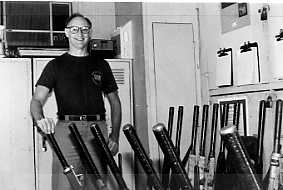
If camaraderie was mostly what I missed before coming to Miller, there
were other goodies in store to make the tower an even more pleasant place
to call home . . .
Chief among them is location. Now I don't mean to be unduly critical
of the location of the last tower I served, but the tranquil setting of
Miller is by far a vast improvement. There are trees, wildflowers, the
river, wildlife, the stars, the dark sky at night, and the crisp country
air. The nearest civilization is about half a mile away, and things are
quiet.
Another treat is the use of armstrong levers. Known as an electro-mechanical
interlocking, all of the switches and associated locks controlled by Miller
are thrown by hand using levers located in the office portion of the tower.
The levers engage the switches through a system of pipelines linked directly
to the outside. Of the many thousands of such interlockings in use across
the country earlier this century, there are probably fewer than two dozen
remaining today. Make no mistake about it... Miller, with its electro-mechanical
plant, is a member of a very exclusive category of towers. I consider it
a high honor to be part of this heritage. In a decade or so, when there
are none left, I can say I was with one of the last. This is history!
Electro-Mechanical Interlockings . . .
Here is a list of railroad interlocking towers in the United States
that still have armstrong lever assemblies in service. To qualify for this
listing, the interlocking must have both levers and pipelines in use. The
list has been compared with the records of a number of interlocking tower
experts around the country. They include Rich Ballash of Latrobe, Pennsylvania;
Pat Seward of Bay City, Michigan; Mike Kiriazis of Cicero, Illinois; Kent
Hannah of Roanoke, Texas; Mike Welsh of Linthicum, Maryland; Charlie Whipp
of Lapeer, Michican; and Eric Schmelz of North Tonawanda, New York. This
list is subject to correction.
- Cherry Run, West Virginia - Miller - CSXT (B&O)
- Hancock, West Virginia - HO Tower - CSXT (B&O)
- Cumberland, Maryland - Viaduct Junction - CSXT (B&O)
- Hyndman, Pennsylvania - CSXT (B&O)
- Keyser, West Virginia - CSXT (B&O)
- Hardman, West Virginia - CSXT (B&O)
- Tiffin, Ohio - IH
- Lima, Ohio - NS Tower - CR (PRR)
- East Dubuque, Illinois - East Cabin - CCP (IC)
- Gary, Indiana - Ivanhoe - CR (NYC)
- Hammond, Indiana - State Line - IHB
- Grasilli, Indiana - IHB
- Chicago Ridge, Illinois - NS (Wabash)
- Chicago, Illinois - B-12 - SOO
- Chicago, Illinois - 75th Street - CSXT (B&OCT)
- Chicago, Illinois - Brighton Park Junction - CR (PRR)
- Springfield, Illinois - Ridgely - SPCSL (GMO)
- Flatonia, Texas - Tower 3 - SP
- Sherman, Texas - Tower 16 - SP/TP

Photos, above.. Signal maintainer Dave Wood (left) points to a device
called a 'crank' which redirects the motion of the pipeline in its function
of throwing switches manually from within Miller Tower. Pipeline networks
can extend several hundred feet, and might not even be in a straight line
(as shown in the photo from the tower's west window above, right). In spite
of this, levers are usually rather easy to operate. This is due to regular
maintenance, plus the mechanical advantage offered by a lever moving three
feet to move a switch by only four inches.
Photo below.. Mosaic view looking east (geographically south) from
the steps of Miller Tower. Tracks just beyond the signal bridge, left to
right, are the Lurgan Subdivision, No.4 track, No.1 track, and No.2 track.
The Potomac River is beyond the woods off to the left. It is a frequent
sight to see deer crossing the tracks in the vicinity of the signal bridge
going to and from the river.
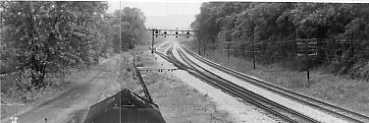
Calling Functions at Miller . . .
One feature about life at Miller is in the way short-term job vacancies
are assigned. The operators at Miller, in addition to their interlocking
duties, are also callers for the clerical personnel in the area. This includes
the five-tower Brunswick to Hancock cluster, plus agencies, janitors, and
various other assignments.
This arrangement has been in effect since mid-1992 when the clerical
calling office at Cumberland, Maryland, was abolished. The vacancy books
for the area were brought to the tower, along with a computer, and Miller
was given assignment responsibility for the various extra lists in the
area.
By filling vacancies locally, where everyone is known to each other,
a spirit of family harmony is enhanced.
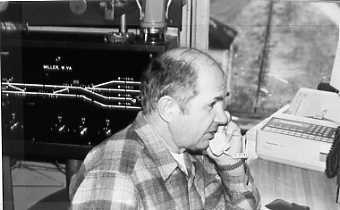
Veteran operator Jim Vargo began his career on the B&O in 1969,
and has been the first-shift operator at Miller for the past three years.
As the tower's office manager, he is also the chief caller.
When I Came to Miller . . .
My only regret in coming to Miller was having to displace someone to
make room for me. Disrupting the status-quo is not often easy. One displacement
can trigger a long chain of events affecting many others. Here is what
happened when QN Tower closed and I exercised my right to come to
Miller:
- 1. I displaced Larry from 2nd shift Miller.
- 2. Larry displaced Bea from the relief job Martinsburg.
- 3. Bea displaced Doris from 3rd shift West Cumbo.
- 4. Doris displaced Bill from the extra list.
- 5. Bill displaced Debbie from 3rd shift Hancock.
- 6. Debbie got furloughed.
Being furloughed was not so bad, as Debbie had a guarantee. But wait,
there was more to come . . .
Since Debbie was furloughed, the company offered a buyout to the most
senior employee in the area requesting it, thus bringing the number of
employees back to assigned strength.
- 7. Angie, agent at Harpers Ferry, took the buyout. (She had been waiting
for the opportunity, and was quite happy!)
- 8. Dottie, from the extra list, took the agent's job at Harpers Ferry.
(That made her happy, too!)
- 9. Bill, from 3rd shift Hancock, took the extra list. (That's where
he had been in the beginning, before all this started.)
- 10. Debbie, from being furloughed, took 3rd shift Hancock. (That's
where she had been in the beginning, too.)
So when I came along and splashed into the pond, it did cause quite
a few waves. But when things settled down, most of those who were affected
were happy with what resulted. In any event, other changes not connected
to my coming to Miller later took place affecting some of those mentioned
above, and these changes would have occurred anyway.
The Operators at Miller . . .
The following are operators who have served at Miller Tower over the
past 12 months:
- Allen Brougham
- Dick Campbell
- Cindy Derrick
- Debby Haddix
- Ranota Koontz
- Larry Lee
- Bill Lowry
- Debbie Mentzer
- Hoppy Ridgeway
- Ginger Stanley
- Danny Unger
- Jim Vargo
- Brenda Weller
The Long Drive . . .
Miller Tower is not exactly around the corner from where I live. Indeed,
by its shortest route, it's 105 miles. And that's just in one direction!
So while I hold the record for the longest commute to Miller, it's still
a lot better than, for example, the ordeal faced by many government workers
from the vicinity of Miller who regularly commute to their jobs in Washington.
Many take the train from Martinsburg. But that's a two-hour ride. And to
that must be added the time to get to the station, and then to their job
once in Washington. For those who drive to work, there is really no direct
route, and rush-hour motoring is no picnic. But many do it. For me, though,
my commute is a mostly direct route, primarily on interstates, outside
of rush hour... and it's door to door! I can make the trip in two hours
if I try, but I usually relax and take about ten minutes longer. It's a
pleasant trip.
But even a pleasant trip, if it's made every day, can be monotonous.
So in due time I came up with an idea to make the ride more interesting,
to wit: Allen's License Tag Survey...
THE SURVEY: Several months ago I noticed how so many cars would pass
me on Maryland interstates when I stuck to the 55 MPH speed limit. It soon
dawned on me that I was in an excellent position to conduct a percentage
survey of vehicles using these interstates based upon the license plates
they displayed. (The percentage from Maryland, the percentage from Pennsylvania,
etc.) By conducting the survey each day, and by counting all of the vehicles
I saw in the course of a month, I reasoned that I could develop enough
of a pattern to establish figures close to the actual percentages for all
vehicles to use selected segments of the route during that same period.
I began my project this past June.
I established three different highway segments - two on I-70 and one
on I-81 - which I felt would produce indigenous results. I was anxious
to see how the patterns might vary, both in relation to the other segments
that month and in relation to the same segment through subsequent months.
So using a shorthand system to record license plate origins, and still
keep my eyes on the road, I developed my figures which I later put on computer.
It produced interesting results.
It then occurred to me that my findings just might be of interest to
the Maryland Department of Transportation. Why not? So at the end of the
month I sent my figures to the state. It was then my pleasant surprise
to get a reply from the state's secretary of transportation. He appreciated
the information. He had referred my figures to his office of planning.
He even gave me an address for me to send future figures directly, if I
chose to do so. I did. I later got two more letters from the office of
planning. They appreciated the information, too.
Perhaps the state was just being polite. Maybe they'll never even more
than glance at what I sent. But the figures are there if they find a use
for them. In the meantime I'm having fun, and I look forward to seeing
the results of my survey each month.
Some History . . .
Once again, I am indebted to historian Mike Welsh for some historical
input. Mike is probably the area's leading historical expert on B&O
interlocking towers, and he has previously contributed information for
the Bull Sheet as part of features about HX, JD and QN Towers.
Present-day Miller Tower was constructed to a standard plan dated August
23, 1911, drawn by the B&O's office of architect for a frame signal
tower structure size 15 X 21 feet. Other frame towers of that period followed
a similar plan and were variously larger or smaller depending upon the
amount of workspace that was needed. A number of these towers survive today.
A noticeable architectural feature of this plan is the shingled extension
just beneath the top floor windows of the building. Some of the surviving
towers from this plan have more recently had this extension removed in
favor of siding modifications.
The track side and rear of the tower were each provided with six windows,
the west side with four windows, and the east side with three windows and
a door. The operator was thus provided a means of ventilation from all
sides.
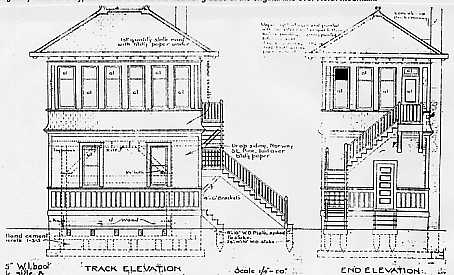
According to an ICC valuation report issued September 1919, the tower
was built and in service in 1913. But according to a B&O signal pricing
publication, the date is listed at 1912. The installation replaced an earlier
facility at or near the same location, a 13'5" X 24'9" structure
housing a 36-lever Saxby & Farmer machine with 20 working levers. The
new Miller installation was a 40-lever Union style #52 electro-mechanical
machine including 36 working levers and four spares.
The interlocking was located at the west end of Cherry Run Yard, a major
interchange point between the B&O and the Western Maryland. According
to early track charts from the Mike Welsh collection, there were at one
time ten yard tracks in Cherry Run Yard, plus some stub-end tracks. At
the tower there were three mainline tracks and one yard lead for a total
of four tracks in front of the tower, and two penstocks within or near
the limits of the interlocking. The penstocks were supplied by two 55'
concrete water reservoir tanks atop the hill across the tracks from the
tower. The penstocks and concrete tanks were retired in 1955, but the tanks
are still there.
Some noteworthy modifications to the present building included the installation
of electric lights and the retirement of oil lamps in 1929, the extension
of the second floor on the rear of the tower to accommodate signal equipment
in 1936, the rebuilding of the interlocking machine in 1952, and the introduction
of running water in 1955.
The present 20-lever interlocking machine at Miller dates from 1952.
It now has six switch levers, four locking levers, and ten spares. The
interlocking consists of two switches and two sets of crossovers, with
two tracks west of the plant and four tracks east of the plant. The two
tracks west of the plant are the main tracks of the Cumberland Subdivision
toward Hancock and Cumberland, and the four tracks east of the plant include
the single main track of the Lurgan Subdivision toward Hagerstown, and
the low-grade freight line and two other main tracks of the Cumberland
Subdivision toward West Cumbo and Brunswick. The low-grade line follows
a circuitous route to West Cumbo avoiding the heavier grades affected by
the other two tracks over North Mountain.
Cherry Run Yard is gone now, except for two tracks used on occasion
for the storing of track equipment. Much empty space remains where the
other tracks were removed several years ago.
Miller was once a key point on the heralded Alphabet Route, also known
as the Central States Dispatch Route, which involved the Reading, the Western
Maryland, and the B&O. The bridge across the Potomac River at Cherry
Run was then a connection track with the mainline of the Western Maryland
at Big Pool on the Maryland side of the river. The WM line west of Big
Pool toward Cumberland is now torn up, but about two or three trains a
day in each direction still use the bridge to and from Hagerstown and points
north and east.
Another facet in the life of Miller Tower is its being subject from
time to time to inundation. Its worst flood occurred in 1936 with water
reaching the height of the second floor. More recent floods affecting the
building occurred in 1972 and 1985. Twice during the past year the river
did overflow its banks at Miller, but the tower itself was not threatened.
More on Miller Tower . . .
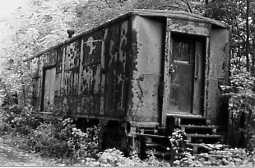
Above.. A hallmark of the area is the old B&O Railway Express
car parked on a captive section of track next to the driveway to the tower.

Above.. Valves situated between the pair of old water tanks atop the
hill across the tracks from the tower. The tanks were retired from service
in 1955.
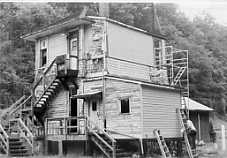
Above.. In this photo, taken in October 1993, company painters are
at work giving the tower a fresh coat of paint. The new scheme, once completed,
is gray with blue trim.
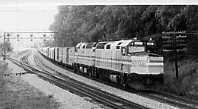
Above.. Amtrak's Capitol Limited passes Miller Tower twice each day,
seen here on its westbound journey en route to Chicago.

Above.. Snow at Miller! Winter scenes befit the isolated and serene
setting of Miller Tower. But driving to the place can be a challenge. Having
a snow shovel in the car in winter months is a must. On the occasion that
this shot was taken, I made it. But later, following the infamous March
1993 blizzard, all roads to the tower were closed. On that occasion, I made
it in by freight train from Martinsburg, and I spent my nights in a motel.

Above.. The Cherry Run Railroad Club is a group of railfans which
meets several times a year during warm weather months in a grove between
the CSXT mainline and the Potomac River. There they enjoy a picnic along
with their blend of fellowship within sight of trains. The organization
has no president, and no dues (except to pay for the food), but they do
have an official cap.
An Epilogue . . .
This has been one of those rare occasions that I devote an entire issue
- except for current news items - to a single topic. Previous dedicated
issues involved the Parkton Local, HX Tower, and JD Tower. These were
all very close to my heart. They deserved the honor that a dedicated issue
can bestow.
But in each of these occasions, what involved was the spirit of remembrance
after the topic involved had ceased to exist. The Parkton Local had ended
service three decades earlier, HX Tower had closed two years earlier, and
JD Tower had closed just the month before. To each I reported upon things
straight from the heart, but it was all after the fact.
This time, though, things are different. Miller is still very much a
living entity. That the place is so pleasant a place to be, that it is
within such a wonderful family of towers and fellow operators, and that
it is one of the so very few remaining facilities where the switches are
still thrown with traditional pipelines and levers, I did not want to wait
until after its final day to honor Miller Tower with a dedicated issue.
Its final day will come, of course. Perhaps in a year, perhaps longer.
But that it is still very much a part of the scene today, and I'm a part
of that scene, I wanted to use the opportunity these pages provide to share
my feelings about this living legend before there is nothing left of it
but its history. Today it lives history. It is my own high honor to be
a part of it. This comes from the heart.
- - - - - - - - - - - - - - -
CSXT's Last GP35 Removed From Roster
CSXT's last GP35 has been removed from the roster. Unit 4426, formerly
of the RF&P, was deleted on September 29.
CSXT's Pittsburgh Dispatching Functions Transfer to Florida
CSXT's Pittsburgh Terminal dispatching functions were move to Jacksonville,
Florida, on October 11.
CSX Raises Dividend
CSX Corporation raised its quarterly dividend to 44 cents from 38 cents
a share effective with the December 15 payment.
Nova Tower Closes
The CSXT tower at Nova, Ohio, closed on October 18.
West Virginia Northern Files for Abandonment
The West Virginia Northern has applied for abandonment. There are local
interests who would like to make the railroad into a tourist line.
Buffalo Central Terminal May be Doomed
The once magnificent Central Terminal in Buffalo, New York, could be
close to demolition. According to the September issue of the Conrail Technical
Society Journal, three separate developers have failed to improve the property
and market it for a variety of uses, and a fourth tried to buy the property
but was unable to secure funding. The city is taking the current owner
to court for building code violations, and has threatened demolition as
a way of stopping frequent fires set by vagrants and vandals.











